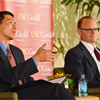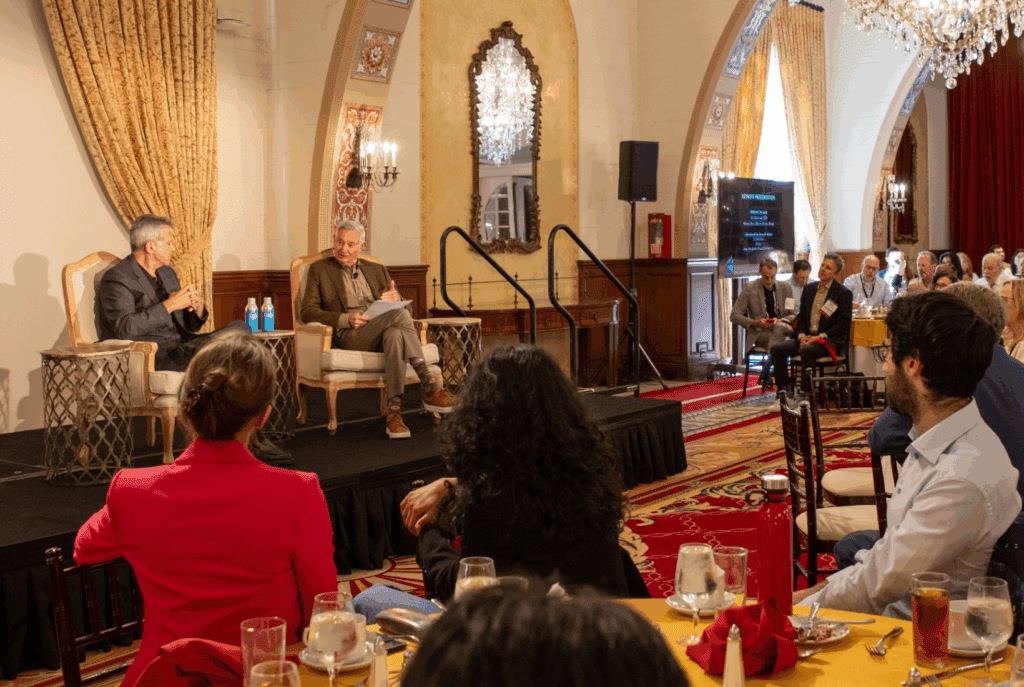Justice Goodwin Liu, former U.S. Solicitor General Gregory Garre and USC Gould Prof. Rebecca Brown offered perspective
-By Gilien Silsby
The U.S. Supreme Court’s forthcoming Term was the subject of the USC Gould School of Law’s sixth annual Supreme Court Preview, along with discussions of several important cases on the topics of marriage, voting and education that the court decided in its last Term.
.jpg) |
| Left to Right: Gregory Gare, Rebecca Brown, Goodwin Liu, Robert Rasmussen, Elizabeth Garrett |
Moderated by Elizabeth Garrett, USC provost and senior vice president for academic affairs, the Preview drew an audience of more than 330 alumni, law and undergraduate students, faculty, staff and local attorneys to the event held at USC’s Town and Gown.California Supreme Court Justice Goodwin Liu, former U.S. Solicitor General Gregory Garre and USC Gould Professor Rebecca Brown offered perspective and insight at the event, which was co-sponsored by student chapters of the American Constitution Society and the Federalist Society.
.jpg) |
USC Gould Dean Robert K. Rasmussen said the Supreme Court Preview is a highlight of the year.
The panelists opened the discussion with the Supreme Court’s ruling on Fisher v. University of Texas, which challenged affirmative action in state university admissions policies.“Here at Gould, our primary mission is to educate the next generation of lawyers, the people who are going to lead our community,” he said. “To be a lawyer is to be an engaged citizen. … We pride ourselves on producing alums who are interested in the most important topics of the day. There’s nothing more pressing and important than what is happening on the Supreme Court.”
The Court’s 7-1 ruling sent the case back to the 5th U.S. Circuit Court of Appeals for stricter application of the equal protection test — avoiding what some had expected to be a dismantling of affirmative action in higher education.
Garre, who argued before the Supreme Court on behalf of the University of Texas, said the ruling “was perhaps one of the most surprising decisions of the Term. … Going into the argument, the question was not who was going to win or lose, but what was the Supreme Court going to do to affirmative action?”
Two other important cases decided last Term involved same-sex marriage: Hollingsworth v. Perry, involving California’s Proposition 8, and Windsor v. United States, involving the federal Defense of Marriage Act.
 |
| Goodwin Liu and Gregory Garre |
Despite its ruling requiring the federal government to recognize all valid state marriages equally, the Supreme Court did not resolve the key question of whether the Constitution requires states to allow same-sex couples to marry, Brown said.
“The court did not rule on the question whether people have the right under the Constitution to marry the person of their choice,” Brown said. “Prop. 8 raised that question, but the Supreme Court, on procedural grounds, avoided the question. They made clear at oral argument that they were hesitant to impose a national rule that would invalidate the laws of the 37 states that currently ban same-sex marriage. … Nevertheless, the issue is not going away. The justices are going to have to face it because cases are hurtling toward the Supreme Court at breakneck speed.
“Because we have 13 states and the District of Columbia that now allow people of the same sex to marry, the system is very unstable,” she continued. “Being married isn’t like allowing gambling in one state and not in another. …Marital status infiltrates peoples’ lives in many ways, and couples who are married in one state and then move to a state that does not recognize their marriage face all kinds of challenges to personal rights, property interests and child custody obligations.
“There are many cases currently in the pipeline throughout the country raising the question of how to handle this problem, and creating pressure to have a uniform rule,” she said. “Sooner or later, the court is going to have to come to grips with the fundamental question of who has the right to marry.”
.jpg) |
Attendees at the sixth annual Supreme Court Preview held at USC (USC Photo/Bill Youngblood)Attendees at the sixth annual Supreme Court Preview held at USC (USC Photo/Bill Youngblood)
The panel also discussed several upcoming cases this Term, including Greece, N.Y. v. Galloway, which challenges a township’s practice of inviting local clergy to offer Christian prayers before its public monthly meetings, and McCullen v. Coakley, a case which contends that a buffer zone around abortion clinics in Massachusetts infringes on First Amendment rights.
Bond v. United States is the case on the court’s docket that “wins for colorful facts,” Liu said.
Liu explained that “Here the question is, can the ratification of a valid treaty authorize Congress to pass implanting legislation that it could not otherwise pass absent the treaty?”
Carol Bond, who worked in a chemical plant in Pennsylvania, tried to poison her friend after learning she was impregnated by Bond’s husband. The chemicals were applied to her friend’s car door handles, mailbox and doorknobs, resulting in minor injuries to the woman.
“You might think this is quintessentially the kind of domestic dispute that is a matter of local regulation,” Liu said, “but instead of leaving it to the local law enforcement agency in Pennsylvania, federal prosecutors charged and convicted Bond under the Chemical Weapons Convention Implementation Act of 1998, a statute that Congress passed to implement banning the use of chemical warfare — the very chemical weapons ban at issue in the Syria conflict today.
 |
| Gregory Garre and Rebecca Brown |
“Now that the Supreme Court has taken the case, it will have to decide if Congress may pass a law that reaches local conduct traditionally relegated to the states as a matter of local concern,” he added. “Bond’s argument is that when Congress passed the law, it intruded on the rights that the Constitution, in the 10th Amendment, leaves to the states.
“You hear the phrase, why make a federal case out of this, and this is the poster child for that notion,” he said.
The panel said Fourth Amendment search and seizure cases could yield surprising decisions this Term. In particular, the court will probably decide the extent to which police may search the digital content contained on a person’s smartphone as part of a search incident to an arrest.
“The Fourth Amendment is the most interesting area of the court’s jurisprudence right now. This is an area where justices don’t fall into traditional camps,” Garre said. “Justice Scalia, one of the conservative justices who would usually take the side of law enforcement, is an ardent defender of Fourth Amendment rights; the generally more liberal Justice Breyer, by contrast, takes a more pragmatic view and finds himself in the camp of the more conservative justices on this issue.”
In closing, the panelists and moderator discussed the many personalities on the court and weighed in on how its newest members, justices Sonia Sotomayor and Elena Kagan, are faring.
“Elena Kagan and Sonia Sotomayor have been on the court now for awhile, and they’re gaining their own reputation, their own character,” Garrett said. “Elena Kagan for the style of her opinions and Sonia Sotomayor for her compelling life story, for her very active questioning from the bench. I wonder, what do you all think about their influence on the court, how have they changed the court already, and what would we expect, as they’ll both presumably be on the court for decades to come?”
Brown said it can take decades for justices to be understood.
“Some people think that maybe Sotomayor intimidates the lawyers or asks too many pointed questions,” she said. “She has an amazing life story, and I wonder if, as an outsider on the bench, she may feel that it is her role to shake things up a little bit?”
Added Garre: “What I’m amazed at is how well Sotomayor and Kagan have adapted to the work load on the court, which is enormous. They both hit the ground running. … Justice Sotomayor may be out there with a lot of questions, while Kagan kind of sits back, but when she does ask a question or pose a hypothetical, it can be the toughest of them all.”
“Also Kagan’s writing is just wonderful to read,” Garre continued. “Like Scalia, she uses sarcasm and wit, which is always nice. So I think both Sotomayor and Kagan have really added to the court dynamic in a positive way.”

















